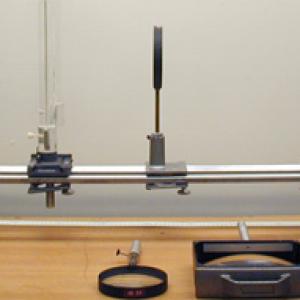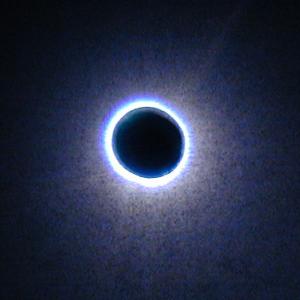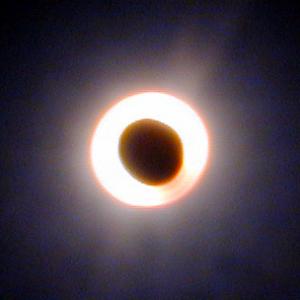College of Liberal Arts & Sciences
6A65.20 - Chromatic Aberration
Chromatic Aberration - Use the slide projector as a distant collimated light source. Place the 30 or 48 cm lens in the optics rail and focus onto the paper screen. On one side of the focal point there will be a red ring at the outer edge of the image, and a blue ring on the other side of the focal point.
A CD or DVD without a silvered coating may be used as an unconventional lens which has a large amount of chromatic aberration. Use the overhead projector or a slide projector as the light source and hold the CD or DVD near a screen to see the focal point and the chromatic aberration around it.
The large Fresnel lens held in front of the output beam of the overhead projector will show a very large chromatic aberration quite easily. Move the lens forward and backward in the beam to show the chromatic aberration on a large screen.
- Paul Gluck, "Compact Disk Optics", TPT, Vol. 40, #8, Nov. 2002, p. 468.
- R. G. Jordan, "Playing Around with Achromatic Pairs", TPT, Vol. 39, #2, Feb. 2001, p. 102.
- Ronald Edge and E. R. Jones, "Why Do Red and Blue Lines Move in Opposite Directions?", TPT, Vol. 22, #7, Oct. 1984, p. 462.
- Jay S. Huebner, David L. Gibbs Jr., and Phil Ryan, "Projecting Chromatic Aberrations", AJP, Vol. 68, #9, Sept. 2000, p. 869.
- Xiangxi Chen, Jacob Huang, and Eddie Loh, "Computer-Assisted Teaching of Optics", AJP, Vol. 55, #12, Dec. 1987, p. 1129.
- David Grossman, "How One Mathematician Solved a 2,000-Year-Old Lens Problem", Popular Mechanics, Vol. 196, #8, Nov. 2019, p. 24.
- "O-380. Color Filters and Carousel", DICK and RAE Physics Demo Notebook.
- G. D. Freier and F. J. Anderson, "Oj-9", A Demonstration Handbook for Physics.
- Richard Manliffe Sutton, "L-49", Demonstration Experiments in Physics.
- Raymond Bruman, "Chromatic Aberration", Exploratorium Cookbook I, p. 27.1 - 27.5.
- C. Harvey Palmer, "Experiment A9: Logitudinal Chromatic Aberration and Secondary Spectrum", Optics - Experiments and Demonstrations, John Hopkins Press, 1962.
- "6, Chromatic Aberration", Experiments in Optics, Part 1, J. Klinger Scientific Apparatus Corp., Bulletin 101.
- Joseph Frick, "#169 - Chromatic Aberration", Physical Technics: Or, Practical Instructions for Making Experiments in Physics and the Construction of Physical Apparatus with the Most Limited Means", p. 198.
Disclaimer: These demonstrations are provided only for illustrative use by persons affiliated with The University of Iowa and only under the direction of a trained instructor or physicist. The University of Iowa is not responsible for demonstrations performed by those using their own equipment or who choose to use this reference material for their own purpose. The demonstrations included here are within the public domain and can be found in materials contained in libraries, bookstores, and through electronic sources. Performing all or any portion of any of these demonstrations, with or without revisions not depicted here entails inherent risks. These risks include, without limitation, bodily injury (and possibly death), including risks to health that may be temporary or permanent and that may exacerbate a pre-existing medical condition; and property loss or damage. Anyone performing any part of these demonstrations, even with revisions, knowingly and voluntarily assumes all risks associated with them.


